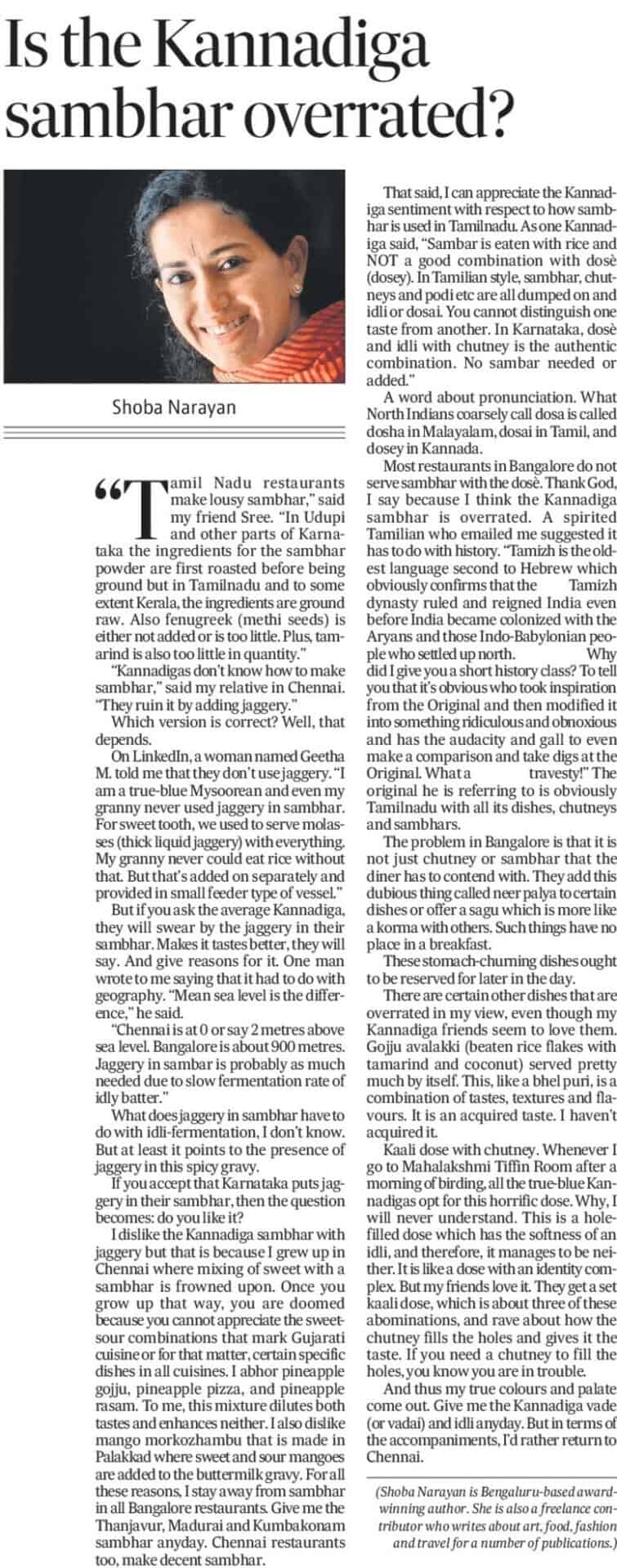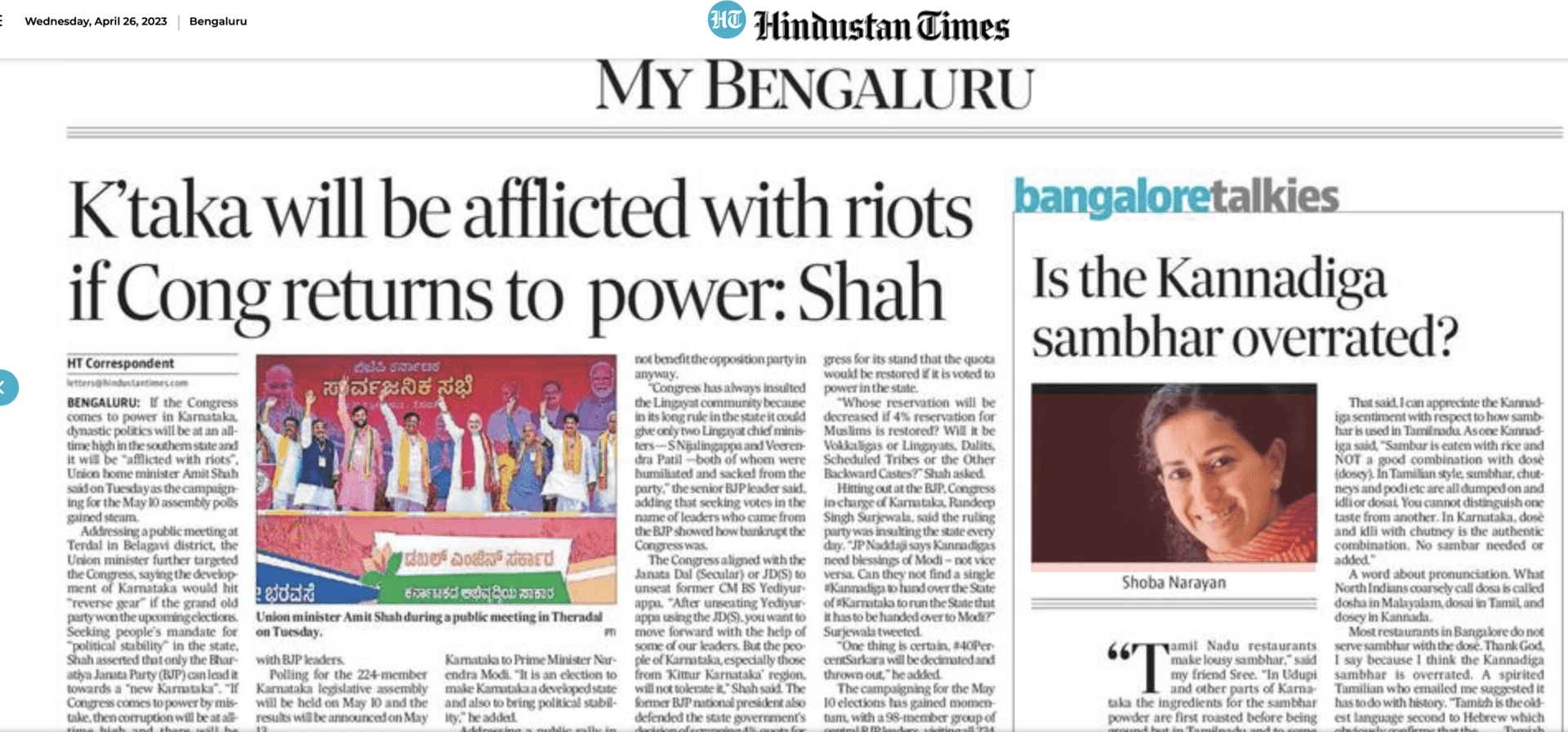And do you need sambhar for breakfast in the first place?
Most restaurants in Bangalore do not serve sambhar with the dosè. Thank God, I say because I think the Kannadiga sambhar is overrated
“Tamilnadu restaurants make lousy sambhar,” said my friend Sree. “In Udupi and other parts of Karnataka the ingredients for the sambhar powder are first roasted before being ground but in Tamilnadu and to some extent Kerala, the ingredients are ground raw. Also fenugreek (methi seeds) is either not added or is too little. Plus, tamarind is also too little in quantity.”
“Kannadigas don’t know how to make sambhar,” said my relative in Chennai. “They ruin it by adding jaggery.”
Which version is correct? Well, that depends.
On LinkedIn, a woman named Geetha M. told me that they don’t use jaggery. “I am a true-blue Mysoorean and even my granny never used jaggery in sambhar. For sweet tooth, we used to serve molasses (thick liquid jaggery) with everything. My granny never could eat rice without that. But that’s added on separately and provided in small feeder type of vessel.”

But if you ask the average Kannadiga, they will swear by the jaggery in their sambhar. Makes it tastes better, they will say. And give reasons for it. One man wrote to me saying that it had to do with geography. “Mean sea level is the difference,” he said. “Chennai is at 0 or say 2 metres above sea level. Bangalore is about 900 metres. Jaggery in sambar is probably as much needed due to slow fermentation rate of idly batter.”
What does jaggery in sambhar have to do with idli-fermentation, I don’t know. But at least it points to the presence of jaggery in this spicy gravy.
If you accept that Karnataka puts jaggery in their sambhar, then the question becomes: do you like it?I dislike the Kannadiga sambhar with jaggery but that is because I grew up in Chennai where mixing of sweet with a sambhar is frowned upon. Once you grow up that way, you are doomed because you cannot appreciate the sweet-sour combinations that mark Gujarati cuisine or for that matter, certain specific dishes in all cuisines. I abhor pineapple gojju, pineapple pizza, and pineapple rasam. To me, this mixture dilutes both tastes and enhances neither. I also dislike mango morkozhambu that is made in Palakkad where sweet and sour mangoes are added to the buttermilk gravy. For all these reasons, I stay away from sambhar in all Bangalore restaurants. Give me the Thanjavur, Madurai and Kumbakonam sambhar anyday. Chennai restaurants too, make decent sambhar.
That said, I can appreciate the Kannadiga sentiment with respect to how sambhar is used in Tamilnadu. As one Kannadiga said, “Sambar is eaten with rice and NOT a good combination with dosè (dosey). In Tamilian style, sambhar, chutneys and podi etc are all dumped on and idli or dosai. You cannot distinguish one taste from another. In Karnataka, dosè and idli with chutney is the authentic combination. No sambar needed or added.”
A word about pronunciation. What North Indians coarsely call dosa is called dosha in Malayalam, dosai in Tamil, and dosey in Kannada.
Most restaurants in Bangalore do not serve sambhar with the dosè. Thank God, I say because I think the Kannadiga sambhar is overrated. A spirited Tamilian who emailed me suggested it has to do with history. “Tamizh is the oldest language second to Hebrew which obviously confirms that the Tamizh dynasty ruled and reigned India even before India became colonized with the Aryans and those Indo-Babylonian people who settled up north. Why did I give you a short history class? To tell you that it’s obvious who took inspiration from the Original and then modified it into something ridiculous and obnoxious and has the audacity and gall to even make a comparison and take digs at the Original. What a travesty!”
The original he is referring to is obviously Tamilnadu with all its dishes, chutneys and sambhars.
The problem in Bangalore is that it is not just chutney or sambhar that the diner has to contend with. They add this dubious thing called neer palya to certain dishes or offer a sagu which is more like a korma with others. Such things have no place in a breakfast. These stomach-churning dishes ought to be reserved for later in the day.
There are certain other dishes that are overrated in my view, even though my Kannadiga friends seem to love them.
Gojju avalakki (beaten rice flakes with tamarind and coconut) served pretty much by itself. This, like a bhel puri, is a combination of tastes, textures and flavours. It is an acquired taste. I haven’t acquired it.
Kaali dose with chutney. Whenever I go to Mahalakshmi Tiffin Room after a morning of birding, all the true-blue Kannadigas opt for this horrific dose. Why, I will never understand. This is a hole-filled dose which has the softness of an idli, and therefore, it manages to be neither. It is like a dose with an identity complex. But my friends love it. They get a set kaali dose, which is about three of these abominations, and rave about how the chutney fills the holes and gives it the taste. If you need a chutney to fill the holes, you know you are in trouble.
And thus my true colours and palate come out. Give me the Kannadiga vade (or vadai) and idli anyday. But in terms of the accompaniments, I’d rather return to Chennai.





This is the typical Tamilian arrogance, which fails to appreciate other tastes. An overdose of Salem Chilly and Tamarind does not make a Sambhar divine.
You were also the one, who said Kuvempu came from North Karnataka. Get your facts right before you write something. That article seemed like an ode to Bommai.
Learn a thing or two from the Malayali gene, which appreciates other tastes. The most popular vegetarian joint in Palakkad is not a Tamilian one but a newly opened restaurant by the name Udupi Kitchen, which serves Udupi Cuisine.
Most towns in Kerala offer an eclectic mix of cuisines to eat out. Contrast this with towns in TN, where all you could find is Chettinad, Kongunadu and Tam Bram Restaurants.